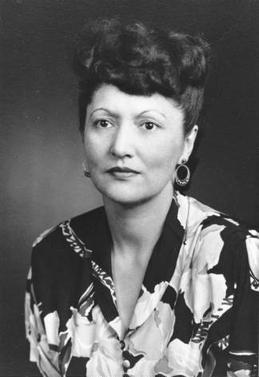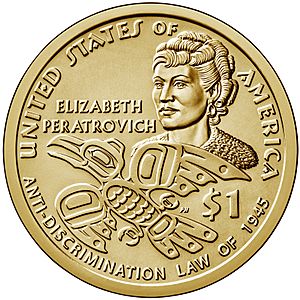Elizabeth Peratrovich facts for kids
Quick facts for kids
Elizabeth Peratrovich
|
|
|---|---|
| Ḵaax̲gal.aat | |
 |
|
| Born |
Elizabeth Jean Wanamaker
July 4, 1911 Petersburg, District of Alaska, U.S.
|
| Died | December 1, 1958 (aged 47) Seattle, Washington, U.S.
|
| Education |
|
| Organization | Alaska Native Sisterhood |
| Known for | Civil-rights activism; Native-American rights |
| Spouse(s) |
Roy Peratrovich
(m. 1931) |
| Children | 3 |
Elizabeth Peratrovich (born Elizabeth Jean Wanamaker, Tlingit: Ḵaax̲gal.aat; July 4, 1911 – December 1, 1958) was an amazing American civil rights activist. She was a leader in the Alaska Native Sisterhood and a member of the Tlingit nation. Elizabeth worked hard to make sure all Alaska Natives were treated fairly and equally.
In the 1940s, her strong efforts helped pass Alaska's Anti-Discrimination Act of 1945. This was the first law of its kind in any U.S. state or territory to fight against unfair treatment.
In 1988, Alaska Governor Steve Cowper created Elizabeth Peratrovich Day to honor her. The date was later changed to February 16, which is when the Anti-Discrimination Act was approved in 1945. In 2020, the United States Mint even put Elizabeth Peratrovich's picture on a $1 gold coin to celebrate her historic achievements!
Contents
Her Life Story
Growing Up and School
Elizabeth Wanamaker was born on July 4, 1911, in Petersburg, Alaska. She was part of the Tlingit nation and her Tlingit name was Ḵaax̲gal.aat. This means "person who packs for themselves."
When she was young, Elizabeth became an orphan. She was adopted by Andrew and Jean Wanamaker, who gave her the name Elizabeth Jean. Her adoptive father was a fisherman and a Presbyterian minister. The Wanamakers raised Elizabeth in different towns in Alaska, including Petersburg, Klawock, and Ketchikan. She went to Ketchikan High School. After that, she studied at Sheldon Jackson College in Sitka, Alaska, and then at the Western College of Education in Bellingham, Washington.
Family Life
On December 15, 1931, Elizabeth married Roy Scott Peratrovich. He was also Tlingit and worked in a cannery. They had three children: Loretta, Roy Jr., and Frank. The family lived in Klawock, Alaska, where Roy was elected mayor four times. Elizabeth was a member of the Presbyterian Church.
The Peratroviches were very worried about racial discrimination and unfairness. They wanted to be closer to lawmakers who could make changes. So, they moved to Juneau, Alaska. Even there, they found a lot of unfair treatment against Alaska Native people. The Peratroviches were one of the first Indigenous families in Juneau to live in a neighborhood where mostly non-Native people lived. Their son, Roy Jr., was also one of the first Indigenous children to go to public schools in Juneau.
Later, the Peratrovich family moved to other places for Roy's studies and work. But they moved back to Alaska when Elizabeth became sick.
Elizabeth Peratrovich passed away on December 1, 1958, at age 47, after fighting breast cancer. She is buried in Evergreen Cemetery in Juneau, Alaska, next to her husband Roy. Their oldest son, Roy Jr., became a famous civil engineer in Alaska. He designed the Brotherhood Bridge in Juneau. He is also a Native artist. Their younger son, Frank, worked for the federal government in Juneau.
Fighting for Equal Rights
In 1941, while living in Juneau, Alaska, Elizabeth and Roy Peratrovich faced unfair treatment. They had trouble finding housing and using public places because of signs like “No Natives Allowed” or “We cater to white trade only.” These signs were common in Alaska at that time.
With help from others, Elizabeth and Roy Peratrovich wrote a bill to stop this unfair treatment in 1941. It didn't pass that year, but they didn't give up! As important leaders of the Alaska Native Brotherhood and the Alaska Native Sisterhood, the Peratroviches used their positions to highlight the problem of discrimination. They also talked to Alaska lawmakers and the governor to support anti-discrimination laws.
Their granddaughter, Betsy Peratrovich, shared a story about their efforts. Elizabeth and Roy once invited a lawmaker for coffee to discuss their cause. They used the little money they had, hoping it would be enough. The meeting was successful, and they had just enough money for their drinks! Many other Alaska Native people also worked hard to raise awareness about unfair treatment back then.
In 1945, representing the Alaska Native Brotherhood/Sisterhood, they brought another anti-discrimination bill to the Alaska Senate. Elizabeth Peratrovich was the last person to speak. She gave a powerful speech, asking for equal treatment for Indigenous people.
A senator from Juneau, Allen Shattuck, asked, "Who are these people, barely out of savagery, who want to associate with us whites, with 5,000 years of recorded civilization behind us?"
Elizabeth Peratrovich bravely answered:
I would not have expected that I, who am barely out of savagery, would have to remind gentlemen with five thousand years of recorded civilization behind them, of our Bill of Rights.
Her words were very impactful. The Senate voted 11 to 5 to pass the bill. This law made sure that all citizens had "full and equal accommodations, facilities, and privileges" in public places in Alaska. Governor Gruening signed the bill into law in 1945. This happened almost 20 years before the U.S. Congress passed the Civil Rights Act of 1964. Alaska was the first territory or state to end "Jim Crow" discrimination in public places since the Civil War.
Many people believe that Elizabeth Peratrovich's powerful speech was key to passing the historic Anti-Discrimination Act of 1945. In 1992, Fran Ulmer, who was a representative in Alaska, said that Elizabeth talked about herself, her friends, and her children. She described the cruel way Alaska Natives were treated as second-class citizens. She explained how it felt to be unable to buy a house in a good neighborhood or for children to see signs like "No dogs or Natives allowed."
The Peratrovich family's important papers, including letters and news clippings about their civil rights work, are kept at the Smithsonian National Museum of the American Indian. In 1988, the Alaska State Legislature officially named February 16 as "Elizabeth Peratrovich Day."
Her Lasting Impact
- In April 1988, Alaska Governor Steve Cowper created Elizabeth Peratrovich Day. He honored her "courageous, unceasing efforts to eliminate discrimination and bring about equal rights in Alaska." The date was later changed to February 16, to remember the day the Anti-Discrimination Act was approved.
- The Alaska Native Sisterhood created the Elizabeth Peratrovich Award in her honor.
- In 1992, one of the galleries in the Alaska House of Representatives chamber was named after her. It is called the Peratrovich Gallery.
- In 2003, a park in downtown Anchorage was named for Elizabeth and Roy Peratrovich. It has a small amphitheater where concerts and other events are held.
- In 2009, a documentary film called For the Rights of All: Ending Jim Crow in Alaska was released. It was about Peratrovich's important work for civil rights.
- In 2017, the theater in Ketchikan's Southeast Alaska Discovery Center was named in honor of Elizabeth Peratrovich. There is also an exhibit there about her role in the fight for Alaska Native civil rights.
- In 2018, Elizabeth Peratrovich was chosen by the National Women's History Project as one of its honorees for Women's History Month in the United States.
- In March 2019, her obituary was added to The New York Times as part of their "Overlooked No More" series.
- On October 5, 2019, the United States Mint announced that Peratrovich would appear on the back of the 2020 Native American $1 Coin. This made her the first Alaska Native to be featured on U.S. money!
- In December 2019, an apartment building in downtown Anchorage was named Elizabeth Place, after Peratrovich.
- In January 2020, Peratrovich was chosen as one of the "20for2020" women who made extraordinary accomplishments.
- In July 2020, a new mural honoring Peratrovich was unveiled in Petersburg.
- On December 30, 2020, a Google Doodle in the United States and Canada honored Elizabeth Peratrovich. This date was chosen because it was on this day in 1941 that the Peratroviches decided to submit their petition to the governor after seeing a "No Natives Allowed" sign.
- In September 2021, a mural of Peratrovich by Tlingit artist Crystal Worl was put up on the outside of the Juneau Public Library in Juneau, Alaska.
- In November 2021, an episode of the PBS Kids' show Molly of Denali called Molly & Elizabeth aired. It showed the main Native Alaskan characters remembering Elizabeth Peratrovich's legacy.
See also
 In Spanish: Elizabeth Peratrovich para niños
In Spanish: Elizabeth Peratrovich para niños
- List of civil rights leaders
- Alberta Schenck Adams
- Alaska Equal Rights Act of 1945


